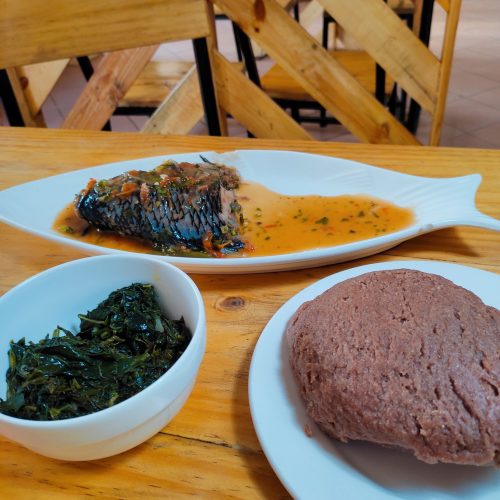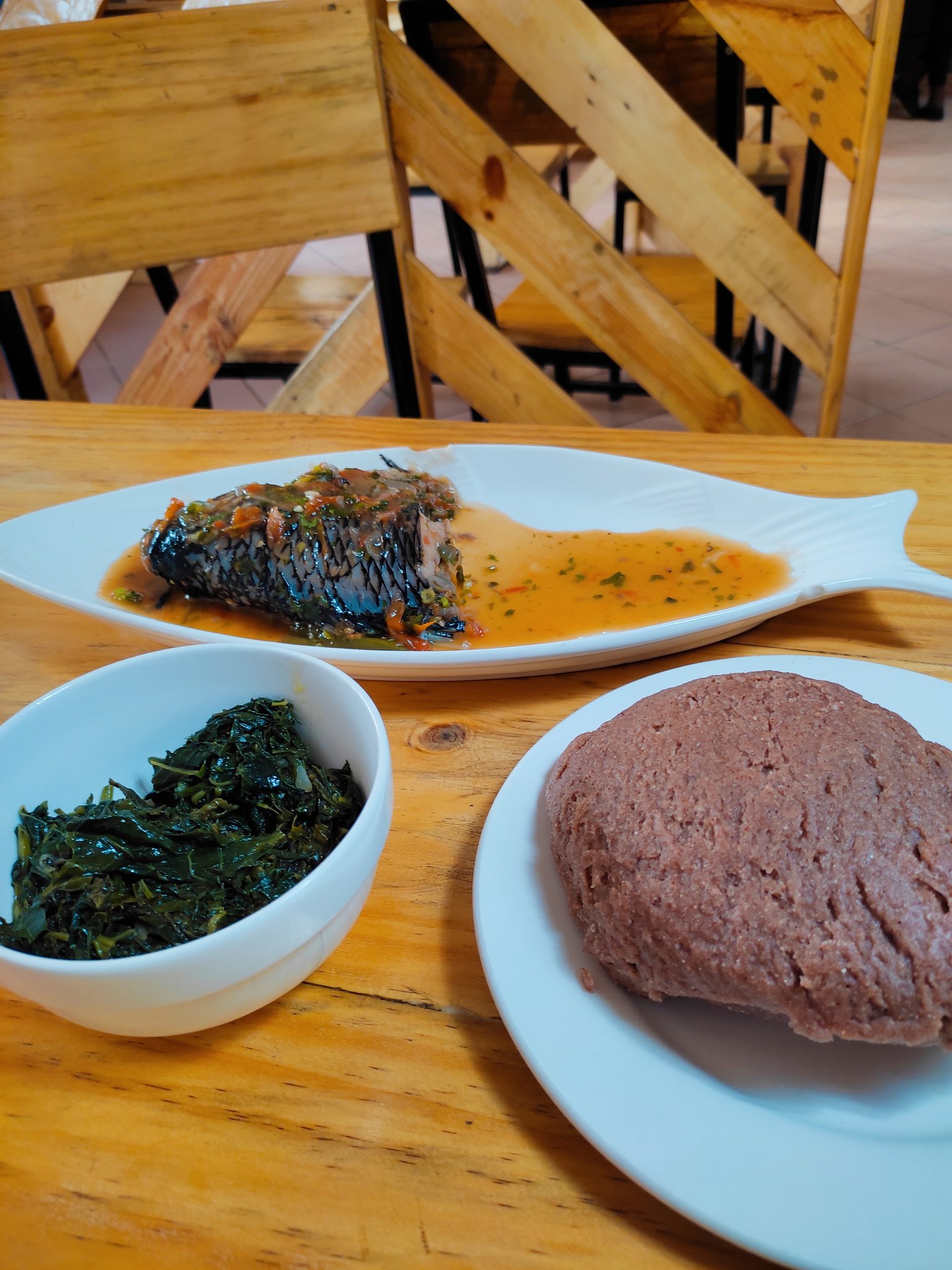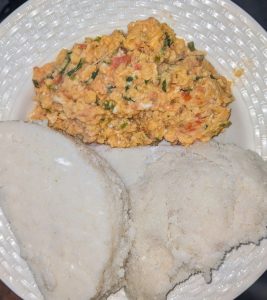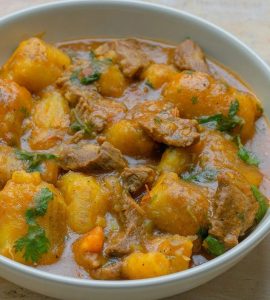Brown ugali is known as ugali wa wimbi, or ugali wa mtama. Which translates to; sorghum ugali, and millet ugali.
Before the Portuguese introduced maize on the East African coast; In the 16th Century, sorghum and millet were our go-to grains.
While drought-resistant, sorghum, and millet offered low yields, so maize replaced them as it offered higher yields, thus ensuring better food security.
Now let’s get into the brown recipe and explore the ancestor’s cuisine, compare it to the white ordinary ugali, and give my thoughts on this type
Ingredients
What is brown ugali made of? Sorghum/ Millet flour and water.
- Flour
- Water
- Salt( optional)
For this case, I used composite flour which is a blend of maize, millet, and sorghum
Tools
- Cooking Stick
- Sufuria (Saucepan)
- A pair of tongs if necessary
For the flour choice, the best for brown ugali is the one you mill by yourself in the posho mill. However, if that is an option, you can’t go wrong with prepacked brands from the supermarket like; Jogoo Wimbi and Wimbi Afya
Procedure
- Gather your ingredients while maintaining a skeptical look, hmm brown ugali flour
- Bring water to a boil covered, add salt if you want, I skip on this because life is salty enough
- Gradually add 1 cup of flour to boiling water while stirring continuously, pound with the wooden stick to avoid clumping, and let it bubble till thick and heavy.
- Reduce heat to low add the remaining flour all at once pound while combining, once homogeneous and solid, start molding into one solid lump while folding into the insides
- Cook till it starts steaming or a whistling sound is produced
- Serve and let cool before digging in, be cautious as serving hot may result in mild burns
Notes
- Ensure that the water reaches a full boil before incorporating the flour; otherwise, the quality of your ugali may be compromised.
- Add flour slowly but surely to avoid big lumps formation which will result in flour patches inside your final ugali. You can opt to blend flours or even add cassava flour for better texture
- To prevent the risk of burning your ugali before it cooks, reduce the heat once the bubbling subsides. Exercise caution to avoid burns from splashes when the ugali is bubbling
- If you love stiffer ugali (I do) add slightly more flour, brown ugali doesn’t get as hard as white maize ugali when hot, however, just serve it soft and let it rest, it solidifies and compacts more on cooling
- Pound properly and evenly to avoid lumps and flour patches, cover ugali to steam and speed the cooking, note that this ugali cooks longer so be patient. Total cook time is at least 20 minutes

Brown Ugali (Ugali Wimbi)
Equipment
- Cooking Stick
- Sufuria (Saucepan)
- A pair of tongs if necessary
Ingredients
- 2 cups Sorghum or Millet flour
- 2 cups Water
Instructions
- Bring water to a boil covered
- Gradually add 1 cup of flour to boiling water while stirring continuously, pound with the wooden stick to avoid clumping.
- Let it bubble till thick and heavy.Reduce heat to low, add the remaining flour all at once, and pound while combining until homogeneous and solid.
- Mold into one solid lump while folding into the insides.
- Cook till it starts steaming or a whistling sound is produced.
- Serve and let cool a little before digging in.
Notes
- Ensure water reaches a full boil before adding flour.
- Add flour slowly to avoid lumps formation.
- To prevent burning, reduce heat once bubbling subsides.
- Pound properly to avoid lumps and flour patches.
- Cover to steam and speed cooking; be patient, it takes at least 20 minutes.
- Don’t dig in immediately as insides are so hot and could lead to serious burns.
Serving
Brown ugali goes great with stews compared to vegetables or eggs, chicken stew to be precise is the perfect combination IMO
You can serve it as you please, the only rule is, there are no rules

Nutritional Information
a) Finger Millet
% Daily Value* Calories 520
Total Fat 6g 8% Saturated Fat 0g 0% Cholesterol 0mg 0% Sodium 0mg 0% Total Carbohydrate 104g 38% Dietary Fiber 12g 43% Total Sugars 0g Protein 16.1g
Vitamin D 0mcg 0% Calcium 0mg 0% Iron 11mg 60% Potassium 600mg 13%
b)Red Sorghum
Daily Value* Calories 480
Total Fat 4g 5% Saturated Fat 0g 0% Cholesterol 0mg 0% Sodium 0mg 0% Total Carbohydrate 100g 36% Dietary Fiber 12g 43% Total Sugars 0g Protein 16g Vitamin D 0mcg 0% Calcium 0mg 0% Iron 6mg 32% Potassium 0mg 0%
Disclaimer
The nutritional information provided is an estimate and may vary based on ingredients, cooking methodology, and quantities used. This should only be used for informational purposes and not for dietary advice.
*The % Daily Value (DV) tells you how much a nutrient in a food serving contributes to a daily diet. 2,000 calories a day is used for general nutrition advice.
How Different is Brown Ugali from White Ugali?
Texture: Smooth, sticky, and gummy compared to the dry crumbly texture of maize ugali
Taste: Tastes richer with a delicate flavor, more flavorful than white ugali however, the flavor is in the aftertaste
Cooking Time: Cooks Longer infact twice as long
FAQs
Brown ugali benefits
Brown ugali either from sorghum or millet or even a blend of both is more beneficial nutritionally than maize ugali, either yellow or white. To reinforce this statement, sorghum, and millet have higher mineral compositions than maize our bodies require, so you will probably meet or exceed your daily requirement from this single dish.
Brown ugali packs less starch than maize ugali which will be beneficial for weight and blood sugar management. The higher fiber content will help in digestion and blood sugar as well
Is brown ugali good for diabetics?
Brown ugali is recommended over maize ugali for individuals with diabetes due to; lower glycemic index, and high fiber content.
Maize ugali is made from flours that are generally highly refined compared to millet or sorghum flours. Also to mention, maize has a higher glycemic index compared to the two; this is due to its higher starch and low fiber content, and also due to the sifting and processing.
A higher Glycemic Index (GI) food, releases glucose quickly after consumption, and may cause high spikes in blood sugar levels. Lower glycemic index foods release the glucose gradually into the bloodstream which is desired for diabetics.
The higher fiber content in sorghum and millet helps manage Diabetes type 2
Is brown ugali good for weight loss?
Higher fiber will help keep you full, this is because fiber is not digestible. Feeling full for long will help reduce food intake, (since you won’t be feeling hungry anyway), thus working towards your goals for weight management.
Thoughts
From a nutritional and healthy lifestyle point, brown ugali wins over maize ugali by a big margin. If so, then why isn’t it widely adopted as the default ugali type? It all comes down to convenience and other factors as outlined below.
- Availability: Maybe this won’t be an issue to the countryside folks, but for Nairobians and Diaspora kings and queens, it is hard getting a hand on sorghum or millet flour. It is even funnier for the diaspora guys because they can’t access even the normal maize meal conveniently, lol. Locals in the village grow these grains by themselves and just grind them at the posho mill. For urban Kenya, you have to rely on packaged sorghum flour which is not that readily available or consistent.
- Price: Wimbi flour for ugali generally costs 15% extra compared to maize flour. With hard economic times and budgeting, it is reasonable why maize flour shadows it. Always blame it on the economy wink
- Culture: People are used to maize ugali, so trying the brown ugali will be hard since it is so different in terms of everything, from texture to taste. People will always default to what they are used to
Relevant Links
Ugali Afya: Is This the Healthiest Maize Meal?
White Ugali with Butter & Salt
Uji: The East African Porridge Ultimate Post




